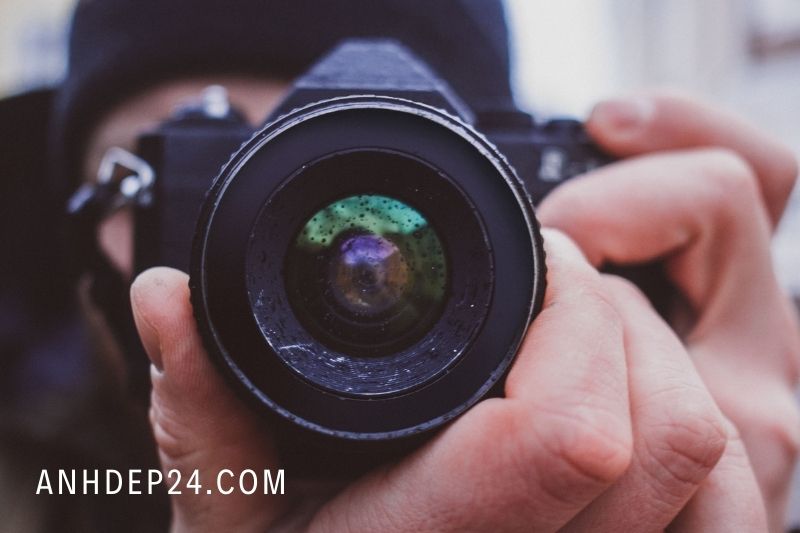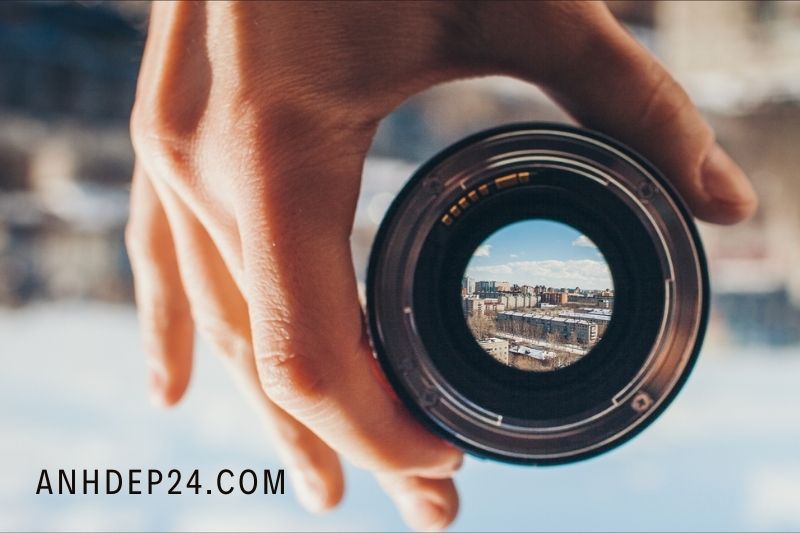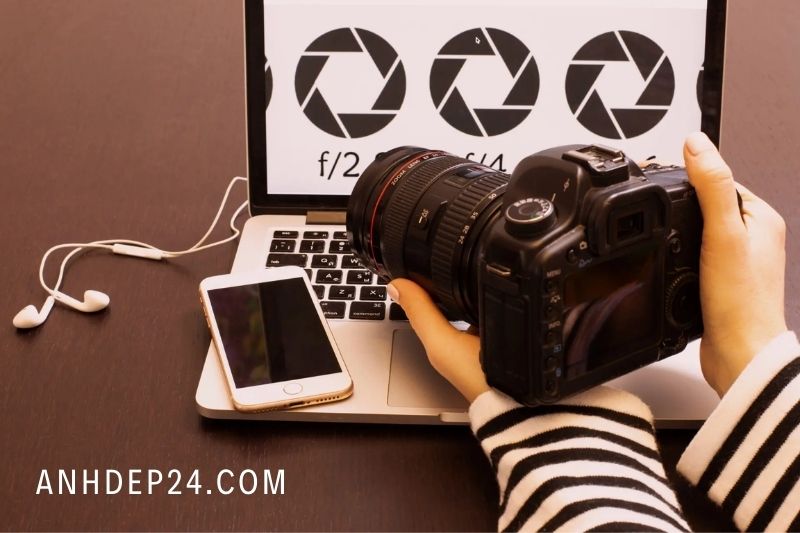How does a camera work? A camera is a device that records images that can be displayed on a screen or photographically recorded. Cameras work by capturing light onto a photosensitive surface inside the camera. The light forms an image that is inverted and reversed left to right.
What Is the Role of Light?
Understanding how light works is essential to understand how a camera works. Without understanding light, photography would not exist.
Let’s not delve into the wild territory of physics.
Light follows a straight line. Photographers, it doesn’t follow curves. It is absorbed and reflected.
Light is a wave for our eyes and cameras. It is very similar to sound because it has different wavelengths, frequencies, and amplitudes. It has a different energy level.
Photographers have the task of capturing the light according to their taste and style.
Core Concept of Cameras

Except for the first pinhole cameras, which didn’t have glass, the main components of cameras are the light detector and the lens.
The camera lens captures light and projects it onto the light detector surface, either film or digital.
You can then create your final image by using a variety of methods.
Photography encompasses everything that takes place between these steps and even before.
You, the photographer, are in control of it.
The Lens

The first contact of light with the camera is through the lens.
The lens allows light to pass through it. It creates the projection of the image by using different optical formulas. It is one of the most powerful tools you have for expression. You need to understand how it works.
Optical Structure
The camera lens you have is not just one lens. It is made up of multiple lenses, both single and group.
This structure was created after careful designing and testing. There are some common formulas like the 50mm F/1.8 and f/1.4. These formulas are identical across different manufacturers and were developed many years ago.
Some advanced and extreme cameras lenses have formulas that were not possible until recently.
The image a lens can project onto a sensor is determined by its optical formula.
Focal Length
Simply put, the focal length determines how much zoom you can use. A shorter focal length allows for a wider field of view. A focal length that is higher or “longer” gives you a wider crop of the scene.
Technically, the focal length refers to the distance between the lens meets the sensor or film.
It is virtually impossible to design a lens with its point of convergence before the front element. However, it is possible. Telephoto lenses, except mirror lenses, must be longer. Wide-angle lenses are often quite long.
Zoom lenses can change the point of their zoom lenses. Prime lenses have theirs fixed, and the elements move only for focus.
Aperture
The maximum light that can pass through the lens depends on its diameter.
An iris is a part of most lenses. The iris narrows the diameter. It functions in the same way as your pupil: the smaller it is, the more light it allows in.
A tighter iris also means a greater depth of field and less background separation.
F-stops are used to indicate the aperture value. The F-stop can be described as a ratio. It is calculated by multiplying the focal length (at the iris) with the diameter.
A 50mm lens with a 25mm aperture diameter would have an F-stop of f/2.
Zooming can change the focal length. If you zoom in on lenses with a constant minimum aperture value, such as a 24-70mm F/2.8, the aperture opens gradually. This ensures that the ratio remains constant throughout.
Focusing
A camera lens, like your eye, sees the world through focal planes. These planes are parallel with the lens’s front element and, in most cases, to the sensor. Tilt-shift lenses and very wide-angle lenses are exceptions.
A lens element must be moved within the lens to bring a plane into focus. This element can be controlled with autofocus or manually by turning a focusing ring.
Each lens has a maximum focusing range. The closer the element of focusing is to the sensor, it will focus further.
Most lenses can focus to infinity, except for macro-only lenses. Infinity is the plane beyond where everything is perfectly in focus. It is possible to go further, but it makes no sense since the image blurs again.
The sensor is often displaced by the focusing element when close-up photography. It is possible to make any not macro-capable lens by attaching extension tubes between its body and the lens.
The focusing ring is usually physically connected to the lens’ focusing mechanism. Manual focus is the best option in this case. Some lenses only have electronic control.
This is common with heavy lenses, such as the Canon 85mm f/1.2II. It’s also used in tiny structures, where a normal focal ring would not be practical (like the Canon 40mm F/2.8 pancake lens).
Stabilization
Modern lenses have an active stabilization element that stabilizes the camera’s motion. This is usually a block with one lens at the back.
It can measure and counteract your handshakes and other movements with the help of a Gyroscope.
Brands may have different names for their stabilization systems. Canon’s is called Image Stabilizer, Nikon calls it VR (Vibration Reduction), Sony calls it OSS (Optical SteadyShot), etc. They do the same thing for the most part.
Weight and Ergonomics
Many factors affect the size and weight of lenses.
Usually, a faster aperture means bigger lenses. A wider zoom range can also result in longer lenses, even though they can be retracted.
The lens must be as bulky as possible, regardless of how large the sensor is.
Also, stability comes with a higher weight.
Manufacturers often design lenses that provide a great balance between their cameras and their lenses. Sometimes, however, this is impossible. Super-telephoto and fast telephoto lenses, like the Canon 200mm F/2, and ultra-wide-angle fast lenses (like Sigma’s14 mm F/1.8), must have large front elements to feel balanced.
Connection to the Camera Body
In this sense, you can choose between interchangeable or fixed camera lenses.
Fixed lenses are most commonly found on consumer-level compact or bridge cameras. Leica is one brand that makes top-of-the-line fixed-lens cameras.
Fixed lenses are not available in many choices. You get what you pay.
You can, however, change the lens of a DSLR (Digital Single-lens Reflex) or MILC (Mirrorless Interchangeable Lens Camera) without removing the camera body.
Each camera manufacturer or alliance has standard lens mounts for connecting to their cameras.
Each mount is designed to hold the lenses steady and safe. This protocol is required to power autofocus and stabilization. Data links can also be used to transfer information about the aperture, focus distance, zoom, and general lens information.
The most prominent camera mount types are the Canon EF/EFS (DSLR), EF–M (cropped sensor mirrorless), and RF (full-frame mirrorless), along with Nikon’s F and Z (mirrorless), Sony’s A and E (DSLR), and many more.
Cameras
After passing through the lens, light reaches the camera, which is detected by a sensor.
Viewfinder
All DSLRs have viewfinders, as do many mirrorless cameras. It can be either optical or electronic.
A DSLR digital camera equipped with an optical viewfinder will capture light from the lens. The light bounces onto semipermeable mirrors once it reaches the lens. The majority of the light reflects onto a pentaprism, then to the viewfinder.
A secondary mirror reflects some of the light downwards into the autofocus sensor.
A mirrorless camera has no optical connection between your eye and the lens. The light always reaches the sensor directly.
The image sensor of a mirrorless camera is shown in this diagram.
Shutter
The shutter is the mechanism that lets light onto the sensor or film for a time (the shutter speed).
The only way to get a digital camera was through a mechanical shutter. They move obstacles in the path of light.
The rolling mechanical shutter, found in most cameras, comes with two curtains. The shutter button is pressed, and the first curtain opens to let the light in through the lens. After the shutter speed is set, the second curtain closes. The sensor is again blocked.
The downside of rolling shutters is the inability to use standard flashes below a certain shutter speed. It is typically around 1/200thof a second. They aren’t exposing the entire frame at once below that.
The curtains have a window in the middle to see the other side.
A flash is, therefore, instantaneous. Only a portion of the frame will lighten if you lower the speed below that speed. High-Speed Sync can help you avoid this problem.
The digital camera era brought electronic shutters to life. They can be used to quickly and continuously readout images.
Nearly every digital camera has a rolling electronic shutter. It works by accumulating data from the sensor in blocks, usual rows of pixels, and then proceeding downwards.
Silent shooting is possible with very low shutter speeds (in some cases, 1/32000th of one second). However, fast-moving subjects can appear blurred due to the asynchronous readout.
Both video recording and live view are possible with consumer-level cameras with electronic shutters.
A global electronic shutter is a feature of some high-end cameras. It simultaneously reads data from all frames, eliminating the possibility of banding distortion. It is used primarily for professional video recording.
Sensor
Digital sensors are made up of pixels. The tiny solar cells known as pixels convert light into electricity.
Digital cameras typically have a single-layer CMOS sensor or CCD sensor. CMOS, a more recent technology allows for individual pixel reading out and low power consumption.
The Bayer mosaic is a layout that uses color filters to arrange pixels. The Bayer mosaic comprises four blocks, each with two green pixels, one red and one blue.
Each pixel is sensitive only to its color so that the final result will be an image with scattered red and green dots.
Debayering is necessary to achieve smooth tones and gradual tones in your photograph.
ISO Sensitivity
Film cameras allow you to swap out the film for a different film. It’s different with digital cameras.
Depending on the ISO value and your camera, there may be multiple outcomes when you or your camera set the ISO value.
Most digital cameras with CMOS sensors have a small amplifier for each pixel. It amplifies each pixel to a higher level depending on the ISO after the exposed frame.
This is the only amplifying factor until a specific value, typically ISO 1600.
ISO, which is also a digital tag embedded in jpg files’ raw or digital amplification, is beyond that.
Digital Conversion and Processing
The digital data is converted from analog data after being read out by the digital camera sensor. This is the job of the analog-to-digital converter.
Modern cameras can convert to 16-bit, but only 14 bits. This gives you more control over post-production and filtering.
14. bit means that there are 16.384 possible values for each pixel. Modern digital cameras have a wide range of color and tone options.
The image processor then processes the pixel data. If you choose jpg output, the processor will perform several algorithms such as filtering, debayering, and compressing.
Your card will then be printed with the final image.
Putting It Into Practice: How To Use A Camera

Modern cameras record images using a lens and sensor (or film). Two people can take the same scene and produce very different images. Cameras are more than just a lens and sensor. Adding extra elements can change the image’s final look.
Composition is one-way images that can be unique. The camera’s lens cannot see everything. Composition is simply a way to describe what the photographer leaves in and what they leave out. It is as simple as moving about in a scene. You can move forward, backward, sideways, kneeling, or stand on a stool to adjust the composition. A small change in the camera’s location can have a huge impact on the image.
Lenses can be used to alter the composition of a photograph. Zoom lenses allow the user to adjust the distance the item appears from the lens. Zoom is usually done on compact cameras with a toggle at the top, while DSLRs and mirrorless lenses have twist controls around the lens. Zoom is a great tool to crop out distracting objects.
Exposure is another important aspect of photography. It determines how dark or light an image is.
A built-in meter measures the amount of light in a scene and is available on digital cameras. The camera’s computer automatically adjusts the exposure while on auto.
Although auto mode can’t be perfect and won’t let you customize the final look of your photo, you can still shoot a properly exposed image (mostly) by choosing “auto” mode from the camera’s menu or a mode dial at the top of more advanced cameras.
Exposure compensation is an option for beginners that allows them to adjust their exposures without learning manual modes.
This function adjusts the brightness and contrast of the image. Advanced cameras have exposure compensation that can be adjusted by pressing the button with the + and – signs and turning its dial near your thumb. Advanced cameras don’t have this feature. On an iPhone, tap the screen and touch the sun icon to move your finger up or down.
After you have selected an exposure mode (most likely auto for new photographers) and decided what elements to include in your composition, press the button at the top right of the camera. Yes, and no.
The shutter release button at the top (technically called the shutter button) will take a photo. However, pressing the button halfway will focus the shot. Press the shutter release halfway while looking through the hole at either the top of your screen (which you call a viewfinder) or at your LCD screen.
Make sure you have the subject in focus. Then push the shutter release to take the photo.
The LCD screen will display the photo you have just taken using a digital camera. To view the photos, press the button with the play symbol. You can also use the arrow keys for navigating through them. You can view and reshoot your images using digital technology.
Although technology has made it possible to snap a photo with just a touch, it was not always easy. Cameras use advanced science and technology to collect light and store it. Although the time machine is science fiction, the camera can preserve memories for a lifetime.
Some relevant articles:
- What Camera Do YouTubers Use? Top Full Guide 2022
- What Is A DSLR Camera? Top Full Guide 2022
- How To Allow Camera Access On Snapchat? Top Full Options 2022
- What Is ISO On A Camera? Top Full Guide 2022
- What Is A Mirrorless Camera 2022? Top Full Guide
FAQ
How does a camera work simple explanation?
Camera lenses take all of the light rays that bounce around and redirect them to one point. This creates sharp images. Sharp images are created when all the light rays collide on a digital camera sensor or a piece of film. Camera lenses can zoom in and out depending on how far away.
How does a camera work physics?
Cameras use convex lenses to create inverted images. Because light rays travel in straight lines until they hit a medium, convex lenses are used to take inverted images. The glass causes light rays to refract or bend, which causes them to form inverted at the other side of the medium.
How is the camera like an eye?
How it works: The Film Camera. Film cameras use the same principles our eyes use to operate film cameras. The camera lens is composed of multiple layers of glass that focus light. The camera aperture is similar to our eye’s Iris. It constricts when necessary to limit the light entering.
Conclusion
After reading this article, you should now be fully aware of the benefits of owning a camera. Whether you’re a beginner or a professional photographer, a camera can help you take your photography skills to the next level. Thanks for reading!
